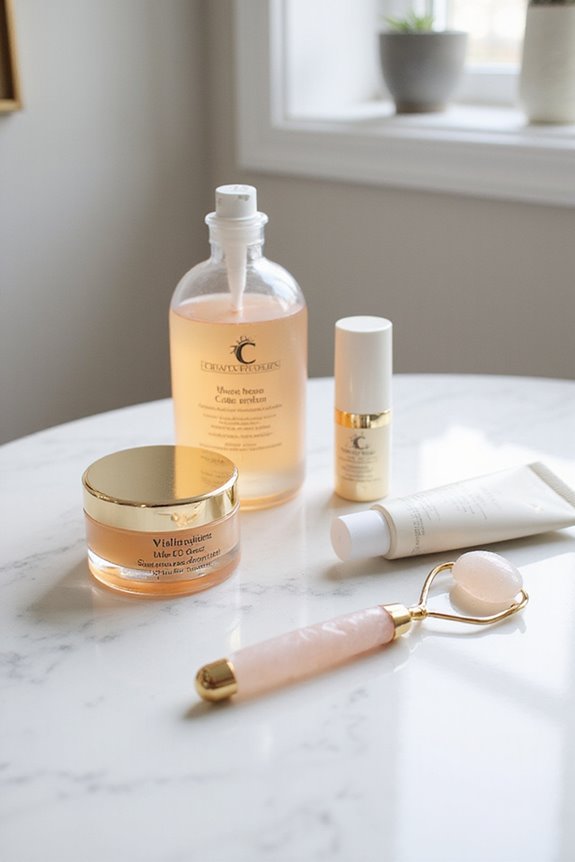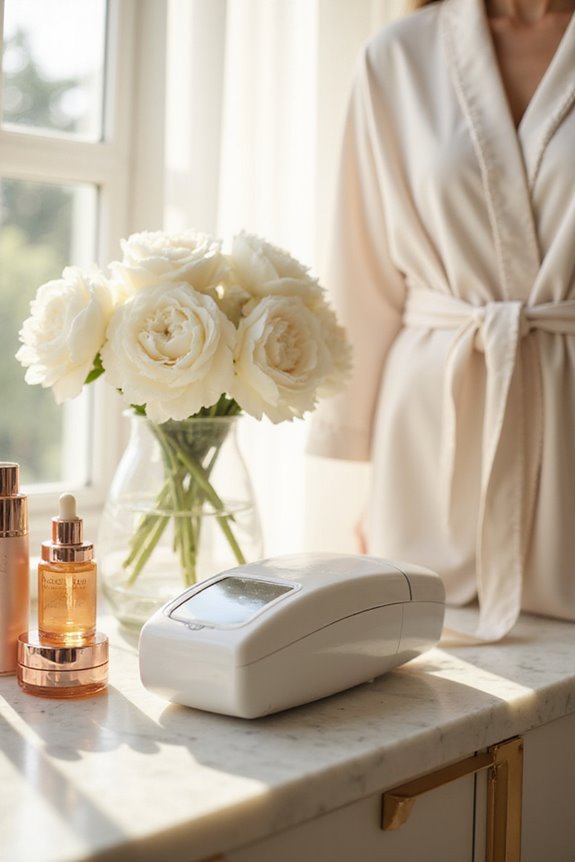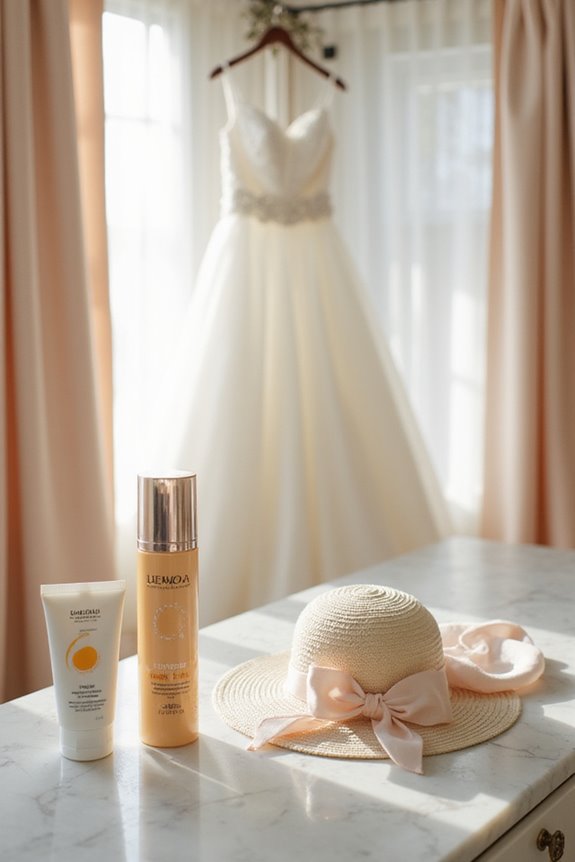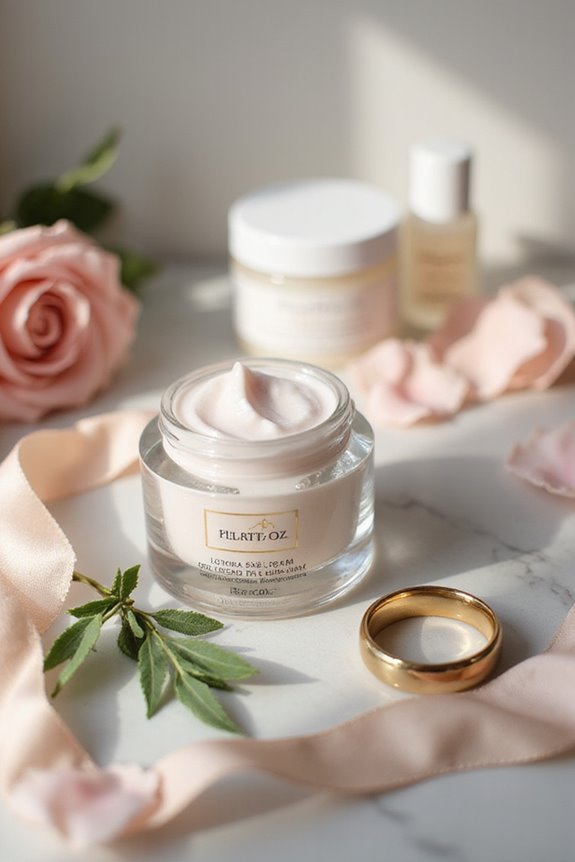To treat hyperpigmentation, we’ve got some great options! First, think about topical treatments like hydroquinone, azelaic acid, or vitamin C. They can lighten those dark spots. We can also explore chemical peels using glycolic acid, which can refresh our skin. Don’t forget about laser therapies; they’re effective but may take time to show results. Finally, sunscreen is our best friend—wear it daily to prevent new spots. Stick around, and we’ll uncover more tips together!
Key Takeaways
- Use topical treatments like hydroquinone or azelaic acid to reduce melanin production and lighten dark spots effectively.
- Incorporate vitamin C into your skincare routine for added brightness and antioxidant protection against hyperpigmentation.
- Consider chemical peels with glycolic acid to exfoliate the skin and diminish post-acne pigmentation through multiple sessions.
- Explore laser therapies, such as Q-switched lasers, to target and break down excess melanin for improved skin tone.
- Prioritize daily sunscreen application to prevent new dark spots and protect against UV damage, reapplying every two hours.
Understanding Hyperpigmentation
When we think about our skin, it’s easy to feel overwhelmed, especially when we notice those dark patches that seem to appear out of nowhere. Let’s take a quick causes overview: hyperpigmentation happens when our skin produces too much melanin, often due to sun exposure, hormonal changes, or even skin injuries.
But don’t fret; there are prevention strategies we all can use! Wearing sunscreen daily is a game-changer, keeping those pesky UV rays at bay. Also, consider wearing protective clothing and seeking shade during peak sun hours.
If we can embrace a healthy skincare routine and stay aware of our skin’s needs, we’ll be better equipped to manage hyperpigmentation together. Remember, we’re all in this skincare journey as a team!
Topical Treatments for Hyperpigmentation

Topical treatments can be a fantastic way to tackle hyperpigmentation and help us regain that even skin tone we all crave. Let’s explore some effective topical agents we can use!
Hydroquinone is often called the gold standard, but we need to be cautious about potential side effects. For a gentler option, azelaic acid at 20% can be a game changer, outperforming Hydroquinone in studies.
Kojic acid and glycolic acid can also help by inhibiting melanin formation. For a little extra boost, we can incorporate vitamin C to brighten our skin.
Combining these agents in our treatment protocols can maximize results but always consult a professional first. With patience and the right approach, we’ll be on our way to healthier skin!
Chemical Peels and Exfoliation Procedures

Chemical peels and exfoliation procedures can be a game-changer for anyone struggling with hyperpigmentation. These treatments use various chemical peel techniques to remove dead skin cells, revealing fresh, radiant skin underneath. They can break down excess melanin, helping to reduce dark spots and promote an even skin tone. For instance, glycolic acid peels are effective for post-acne pigmentation and can show significant results after several sessions.
The exfoliation benefits don’t stop there—these peels also improve overall skin texture, making our skin smoother. Just remember, multiple treatments are usually needed for the best results. So, if you’re considering this option, let’s chat with a dermatologist to find the right peel for our unique skin!
Laser and Light-Based Therapies

Laser and light-based therapies can feel like a revitalizing change for those of us dealing with hyperpigmentation. These treatments target melanin-rich cells, using focused laser beams to break down stubborn pigment. For instance, Q-switched lasers are considered the gold standard, while fractional lasers also improve skin texture.
When considering these options, let’s not forget about laser safety. It’s essential to choose qualified professionals who understand our skin. Treatment costs can vary, but investing in our skin health often pays off in confidence.
Before diving in, consult with an expert who can tailor a plan to our needs. Remember, patience is key; results may take time, but they can be well worth the wait!
Importance of Sun Protection

When we think about battling hyperpigmentation, it’s easy to overlook one of our best allies: sun protection. Regular sunscreen application is essential in preventing new dark spots from forming. Did you know that consistent use can reduce post-inflammatory hyperpigmentation by up to 100%? That’s a win we can all celebrate!
We should look for broad-spectrum sunscreens that shield us from both UVA and UVB rays. And don’t forget about blue light! Reapplying every two hours, even on cloudy days, keeps our skin safe. If we pair sunscreen with sun-protective clothing, we’ll create an even stronger barrier against harmful UV exposure. So let’s make sun protection part of our routine—it’s a simple step toward achieving that even skin tone we all desire!
Systemic and Adjunctive Therapies
As we arm ourselves with sun protection, let’s explore another layer of our fight against hyperpigmentation: systemic and adjunctive therapies.
Systemic Agents
Oral glutathione and tranexamic acid are two exciting options. Glutathione helps lighten skin by reducing melanin production, while tranexamic acid tackles melasma effectively.
Adjunctive Therapies
To boost these treatments, let’s consider antioxidants like vitamins C and E. They can enhance our skin’s resilience. Proper nutrition matters too—addressing vitamin deficiencies can work wonders!
Treatment Considerations for Different Skin Types
Understanding how to treat hyperpigmentation can feel overwhelming, especially since different skin types require tailored approaches.
Fair Skin Considerations
For fair skin, we can use face acids like glycolic or vitamin C to gently exfoliate and even out our tone. Retinol is great for boosting cell turnover without much irritation. Don’t forget sunscreen; a broad-spectrum SPF 30 or higher is a must!
Medium to Olive Skin Considerations
If our skin is medium or olive-toned, azelaic acid and niacinamide are our friends. They help reduce melanin without causing irritation. Superficial peels can be safer, and daily sun protection is still essential.
Darker Skin Considerations
For darker skin, we should prioritize gentle treatments like mild acids. Hydroquinone needs careful monitoring, and natural oils are wonderful for soothing inflammation. Let’s keep our skin healthy and glowing!
Combination Therapy for Optimal Results
Combining different treatments can feel like a secret weapon against hyperpigmentation, especially when one approach just isn’t cutting it. By using multi-modal approaches, we can tackle different aspects of hyperpigmentation more effectively. For example, pairing a topical agent like thiamidol with a glycolic acid peel can enhance pigment reduction and improve skin texture.
When we mix treatments, like using a serum alongside a laser treatment, we’re not just aiming for a quick fix; we’re boosting overall patient satisfaction. A study even showed a 94% satisfaction rate with a combination regimen! So, if one method isn’t working, don’t hesitate. Let’s explore options that combine multiple treatments for the best results. After all, two heads—or treatments—are better than one!
Maintaining Results and Preventing Recurrence
Maintaining the results we’ve achieved in treating hyperpigmentation can feel like a juggling act, but it doesn’t have to be overwhelming. To keep our skin looking its best, we need to make some lifestyle adjustments and stick to a solid skincare routine. First, daily broad-spectrum sunscreen with SPF 30 is a must—think of it as your skin’s shield against those sneaky UV rays. Reapply every two hours, especially if we’re sweating or swimming.
Next, using topical agents like retinol and vitamin C helps maintain our skin tone. Gentle cleansing and moisturizing are essential to avoid irritation. And remember, keeping hydrated and eating well supports our skin. With a little effort, we can keep the glow going strong!
Frequently Asked Questions
How Long Does It Take to See Results From Treatments?
As the saying goes, “Patience is a virtue.” When it comes to treatment timelines, we often find that patient experiences show visible changes within weeks, but complete results can take several months or even longer.
Can Diet Affect Hyperpigmentation Treatment Outcomes?
We believe dietary changes can markedly affect hyperpigmentation treatment outcomes. By addressing nutrient deficiencies, we can enhance skin health, reduce inflammation, and support melanin regulation, ultimately improving our skin’s appearance and treatment efficacy.
Are There Any Home Remedies for Hyperpigmentation?
When we tried DIY masks with natural ingredients like red lentils, we noticed our skin tone evening out. Using these remedies consistently can help reduce hyperpigmentation over time, making them effective options for many.
What Are the Risks of Hyperpigmentation Treatments?
When considering treatments for hyperpigmentation, we should be aware that both laser therapy and topical treatments can cause skin irritation, and improper use might worsen pigmentation. Consulting a professional helps us minimize risks considerably.
Is Hyperpigmentation Permanent or Can It Be Completely Cured?
Hyperpigmentation can feel like a stubborn shadow that never leaves! While it isn’t always permanent, understanding its causes helps us explore effective treatment options. Most often, improvement is possible, but complete cure is rare.





